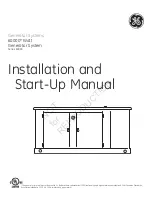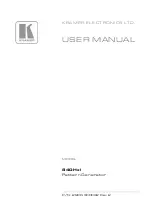
4
•
Always keep metal objects or other materials that can short circuit the terminals of the battery or the
inverter securely away. A resulting spark or short-circuit may not only damage the device, but also
cause an explosion and potentially produce a current high enough to weld a ring or the like to metal.
Remove personal metal items such as rings, bracelets, necklaces, and watches when working on the
device or the battery.
•
Do not connect AC output terminals of the inverter to an incoming AC source (or the grid).
•
Do not connect DC input terminals of the inverter to an incoming AC source.
•
Never use the inverter on vehicles where the positive terminal of the battery is connected to the
chassis.
•
Never connect cables in reverse polarity or short-circuit connected cables. This may blow internal
fuses and may damage the inverter permanently.
•
A fuse should be provided at a distance of max. 30 cm from the battery´s positive terminal. Failure
to do so, may cause damage to the cabling or battery if a fault (e.g. over-current or short circuit)
occurs. Only use high quality copper cable and keep the cable length short.
•
Do not operate appliances that may feed AC main power back into the inverter. This might damage
the inverter.
•
Ensure the device is standing firmly. The device must be set up and fastened in such a way that it
cannot tip over or fall down.
•
Never connect devices that have a higher power requirement than the peak output power of the
inverter. Note that some devices may require more starting current than the type plate of the device
indicates.
Working with Batteries
•
Batteries can store large amounts of energy and improper handling can be dangerous. NEVER
CONNECT to a battery with an unsuited voltage or other unsuitable or damaged batteries
•
Keep children away from batteries and acid.
•
Avoid getting electrolyte on your skin or clothes. It is acidic and can cause burns. If battery acid
contacts skin or clothing, wash immediately with water. Baking soda neutralizes lead acid battery
electrolyte. If electrolyte gets into your eyes, immediately flood your eyes with running cold water
for at least 20 minutes and get medical attention immediately. Eye protection is therefore
recommended.
•
Always keep metal objects or other materials that can short circuit the terminals of the battery or the
inverter securely away.
•
Power-off the device before making or breaking the connections to the battery.
•
Depending on the type of battery, when the battery is being charged (by an optionally connected
solar panel - only PSI1000TX & PSI1500TX), you may notice bubbling in the fluid caused by the
release of gas. As the gas is flammable, avoid naked flames, glowing or electrostatically charged
material and sparks in the vicinity of the battery. Always provide adequate ventilation. Make sure the
inverter is not in direct vicinity of the battery.
•
Observe technical instructions of the seller or the manufacturer of your battery
•
Check if all connections are tight and clean. Loose or dirty connections could result in overheating,
electrical sparks and fire. Use terminal grease where required.
•
Never smoke or allow a spark or flame in vicinity of the battery.
•
Never try to charge a damaged or frozen battery.
•
Do not place the device directly on top of the battery or vice versa or on a surface constructed from
combustible material.
•
Read your car´s owner's manual. Some vehicle manufacturers may have special requirements before
charging or discharging the vehicle´s battery (e.g. fuses that have to be removed or certain security
demands).
Environment:
•
Only use the product in environments from -20°C ~ 40°C.
•
Do not operate the product in damp, wet or dusty environments: Never expose the inverter to rain or
snow. Doing so may result in damage to the inverter or other equipment installed in the system or
result in electric shock or fire. Do not operate the unit in explosive atmospheres, such as in the
presence of flammable liquids, gases or dust. Do not put batteries, or anything that should be
protected from sparks around the inverter. Doing so may result in fire or explosion.
•
To avoid heat accumulation, do not cover the device. To prevent overheating , ensure that air inlets
and ventilation is not obstructed. Do not expose the device to a heat source (such as direct sunlight
or heating). Avoid additional heating of the device in this way.
Summary of Contents for PSI1000TX
Page 2: ...2 ...
Page 6: ...6 Front panel of the inverter TECHNICAL DESCRIPTION ...
Page 19: ...19 VORDERSEITE TECHNISCHE BESCHREIBUNG ...
Page 30: ...30 ...
Page 34: ...34 VOORKANT VAN DE OMVORMER TECHNISCHE OMSCHRIJVING ...
Page 48: ...48 PANNEAU AVANT DU CONVERTISSEUR DE TENSION DESCRIPTION TECHNIQUE ...
Page 57: ...57 ...
Page 58: ...58 ...





































